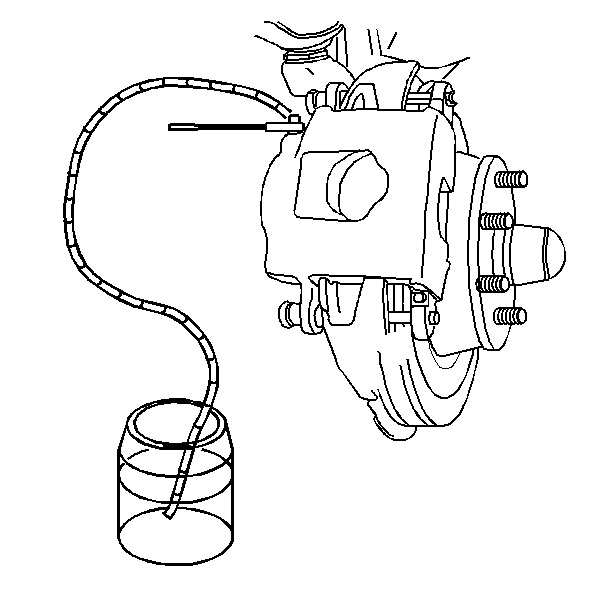If you removed the master cylinder, you can reduce the time required
to bleed the hydraulic system. Bleed the master cylinder before you reinstall
the master cylinder on the vehicle.
If you replaced the Electric Hydraulic Control Unit (EHCU), refer to
Electronic Brake Control Module Replacement
in Antilock Brakes for the proper bleeding procedures.
Use the following procedure if you did not replace the EHCU.
Manual Bleeding

Notice: Brake fluid will damage electrical connections and painted surfaces.
Use shop cloths, suitable containers, and fender covers to prevent brake fluid
from contacting these areas. Always re-seal and wipe off brake fluid containers
to prevent spills.
- Fill the master cylinder reservoirs with DOT 3 motor vehicle
brake fluid.
Maintain the fluid level during the bleeding procedure.
- Perform the following procedure if the master cylinder is suspected
of having air contamination in the bore.
Bleed the master cylinder
before bleeding any brake caliper.
| 2.1. | Disconnect the forward brake pipe connection at the master cylinder. |
| 2.2. | Allow the brake fluid to flow from the connector port. |
| 2.3. | Connect the brake pipe. Do not tighten the brake pipe. |
| 2.4. | Apply the brake pedal slowly. Allow the air to bleed from the
loose fitting. |
| 2.5. | Tighten the fitting before releasing the pedal. |
| 2.6. | Wait for 15 seconds. |
| 2.7. | Repeat this sequence, including the 15-second wait, until all
of the air is plunged from the bore. |
| 2.8. | Repeat the procedure for the rear pipe after all of the air is
removed from the forward connection. |
- Perform the following procedure in order to bleed the brake system:
| 3.1. | Bleed the right rear. Bleed both bleeders one at a time (for Dayton-Walther
only). |
| 3.2. | Bleed the left rear. Bleed both bleeders one at a time (for Dayton-Walther
only). |
| 3.3. | Bleed the right front. |
| 3.4. | Bleed the left front. |
- Attach a hose to the caliper bleeder valve. Immerse the opposite
end of the hose into a container partially filled with clean brake
fluid.
- Slowly apply the brake pedal one time and hold the brake pedal.
- Loosen the bleeder valve in order to purge the air from the caliper.
- Tighten the bleeder valve and slowly release the pedal.
- Wait for 15 seconds.
- Repeat the sequence, including the 15-second wait, until all of
the air is purged from the caliper.
- Continue steps 4-9 at each wheel until the brake system
has been bled.
- Inspect the brake pedal for sponginess.
- Repeat the bleeding procedure if the brake is spongy.
Pressure Bleeding
Tools Required
J 33855 Pressure
Bleeder Adapter
Notice: Brake fluid will damage electrical connections and painted surfaces.
Use shop cloths, suitable containers, and fender covers to prevent brake fluid
from contacting these areas. Always re-seal and wipe off brake fluid containers
to prevent spills.
Use a diaphragm type pressure bleeder. The bleeder must
have a rubber diaphragm between the air supply and the brake fluid in order
to prevent the following from contaminating the hydraulic system:

- Fill the pressure tank at least 2/3 full with brake fluid. Bleed
the bleeder each time the fluid is added.
- Charge the bleeder to 140-170 kPa (20-25 psi).
- Connect the hose from the bleeder to the adapter.
- Open the tank valve.
- Bleed the brake system in the following sequence:

- Attach the hose to the
bleeder valve. Immerse the opposite end of the hose into a container that
is partially filled with clean brake fluid.
- Open the bleeder valve at lease 3/4 of a turn. Allow the fluid
to flow until no air is found in the fluid.
- Close the bleeder valve.
- Repeat steps 6-8 at each wheel.
- Inspect the brake pedal for sponginess.
- Repeat the entire bleeding procedure if the brake pedal is spongy.

- Disconnect the line from the bleeder adapter.
- Remove the bleeder adapter J 33855
.
- Fill the master cylinder to the proper fluid level. Refer to
Master Cylinder Reservoir Filling
.




